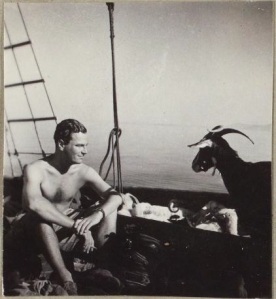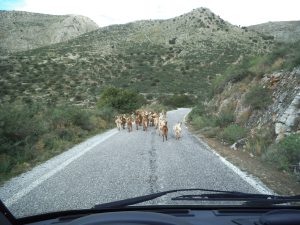 Out of season, there are only two ferry operators who offer the route between Patras and the heel of Italy. Superfast have a huge cruise-like ship which will take me to Bari for €203 or Grimaldi lines, really just a cargo vessel, which docks at Brindisi for €164. I’ve already checked the costs online but I’m hoping for an even better rate at the ticket desks in Patras port, especially as the Grimaldi Lines website indicates that I am entitled to a 30% discount, having already travelled to Greece with their sister company, Minoan.
Out of season, there are only two ferry operators who offer the route between Patras and the heel of Italy. Superfast have a huge cruise-like ship which will take me to Bari for €203 or Grimaldi lines, really just a cargo vessel, which docks at Brindisi for €164. I’ve already checked the costs online but I’m hoping for an even better rate at the ticket desks in Patras port, especially as the Grimaldi Lines website indicates that I am entitled to a 30% discount, having already travelled to Greece with their sister company, Minoan.
The polite but stressed Antonius at the Grimaldi/Minoan check in desk seems surprised when I mention the discount but he looks it up and I also show him the website page on my phone. He says he has to contact the Grimaldi call centre for authorisation but, after several attempts, no one will answer his call. I suggest that I come back later to ease his stress and go back to the motorhome for lunch.
 Trixie is parked up next to a German motorhome who she met at Monemvasia, close to the lorry parking area. While I have lunch I am provided with free entertainment by a dozen or so illegal immigrants seeking the opportunity to stowaway to Italy, where they think they will be able to live a fairy-tale life. They sit around in groups of two or three and wait for the drivers to go and check in. Then they spring into action, looking for ways into the containers or places to hide beneath or on top of the truck.
Trixie is parked up next to a German motorhome who she met at Monemvasia, close to the lorry parking area. While I have lunch I am provided with free entertainment by a dozen or so illegal immigrants seeking the opportunity to stowaway to Italy, where they think they will be able to live a fairy-tale life. They sit around in groups of two or three and wait for the drivers to go and check in. Then they spring into action, looking for ways into the containers or places to hide beneath or on top of the truck.
As one driver walks away, a young man climbs up onto his cab to conceal himself behind the wind breaker. The driver spots him and quickly returns with a handful of rocks. Another joins him with an electric cattle prod. There’s no visible police or port security presence so the drivers take it upon themselves to protect their loads and their jobs. If they are found to be hiding illegals then their company can be fined and they can be jailed.
Another couple gain access to the back of a German truck and when the driver reappears, the remaining illegal (or possibly trafficker) who has shut them inside, just shrugs, apologises and walks away. The driver thinks he has avoided the problem, but I know different so I point out his mistake and then move Trixie to the other end of the port terminal where there are no lorries and therefore no illegals.
When I return to Antonius to check on his progress, he tells me that he’s spoken to the call centre and is now waiting for authorisation. After another hour and some coffee, I return and he is smiling with success. I can now have a ticket for only €122, including a cabin. It takes him forever to process the paperwork and then, in his excitement, he gives me the ticket and bids me a safe journey without taking any money. I point out his omission and, now slightly embarrassed, he takes my card and a small gift of biscuits to thank him for his perseverance.
 By now, it is 3pm and the ferry is due to leave in two hours. I still have to pass through security and Trixie is thoroughly checked over by an official with a sense of humour who laughs when I joke that I’ve only paid for one person. I drive over to the ferry and wait to board. Small lime-green tow-trucks are skilfully loading cargo containers into the belly of the ship and it’s quite mesmerising. However, after 2 ½ hours of watching them, the novelty has worn off, but I’m finally boarded and we leave an hour behind schedule.
By now, it is 3pm and the ferry is due to leave in two hours. I still have to pass through security and Trixie is thoroughly checked over by an official with a sense of humour who laughs when I joke that I’ve only paid for one person. I drive over to the ferry and wait to board. Small lime-green tow-trucks are skilfully loading cargo containers into the belly of the ship and it’s quite mesmerising. However, after 2 ½ hours of watching them, the novelty has worn off, but I’m finally boarded and we leave an hour behind schedule.
 The only communal area which is open, other than the reception, is a small bar/restaurant where the truck drivers are openly smoking despite the ‘no smoking’ signs and, as I have my own food, I decide to hang out in my cabin instead. It’s a large 4-bed outside room with a big picture window but no curtains. The linen is clean but very threadbare and the towels are tiny. There’s a large desk with a redundant phone and a working fridge. I wonder if I have been given a ‘superior room’. I’ve been told I will have the cabin to myself, at least until we dock at Igoumenitsa around midnight. So I take a shower, avoiding the forest of mould growing from the corners, and settle down to a relaxing evening.
The only communal area which is open, other than the reception, is a small bar/restaurant where the truck drivers are openly smoking despite the ‘no smoking’ signs and, as I have my own food, I decide to hang out in my cabin instead. It’s a large 4-bed outside room with a big picture window but no curtains. The linen is clean but very threadbare and the towels are tiny. There’s a large desk with a redundant phone and a working fridge. I wonder if I have been given a ‘superior room’. I’ve been told I will have the cabin to myself, at least until we dock at Igoumenitsa around midnight. So I take a shower, avoiding the forest of mould growing from the corners, and settle down to a relaxing evening.
In the end, no one joins me, but when I venture out at 7am I find several bodies sleeping in the corridor, and the bar is a lot fuller than before. It’s still filled with smoke so I buy a coffee and take it back to my cabin while I wait for the ferry to reach Brindisi. We arrive two hours late at 10am, dock at 10.30 and I finally disembark at 11.00 only to be immediately pulled over by plain clothes immigration officers who want to search the motorhome. I expected this but they subject Trixie to a very detailed search including using a ferocious-looking sniffer dog and unscrewing the seats to confirm that there is a water tank underneath and no tiny illegals. I’m also aggressively interrogated, not helped by all the African and Middle Eastern stamps in my passport. Finally, I’m dismissed and told that last year a single female with a motorhome was found to have 7 illegals hidden within it. One might be construed as a mistake but seven does seem a bit premeditated.
Before I can escape the port, I’m stopped again by customs but this time the officer is in a smart uniform and polite with his questions, even charming. He shows a genuine interest in my travels and waves me off with a smile. I head straight for the fast road towards Lecce and finally stop when I reach the heel of Italy.
 Otranto has a large port filled with pleasure boats and a few grey navy patrol boats. It’s overlooked by the old town, surrounded with thick, fortified walls. I park at the port entrance, opposite an unusual sculpture. It’s an Albanian guard ship which sank in March 1997 while carrying more than 100 refugees. 81 drowned, mostly women and children, and the recovered boat, enhanced with large shards of glass, is a memorial of this event and a reminder of the thousands of illegals who drown whilst trying to flee their war-torn countries to a better life in Europe.
Otranto has a large port filled with pleasure boats and a few grey navy patrol boats. It’s overlooked by the old town, surrounded with thick, fortified walls. I park at the port entrance, opposite an unusual sculpture. It’s an Albanian guard ship which sank in March 1997 while carrying more than 100 refugees. 81 drowned, mostly women and children, and the recovered boat, enhanced with large shards of glass, is a memorial of this event and a reminder of the thousands of illegals who drown whilst trying to flee their war-torn countries to a better life in Europe.
The town is no stranger to death. In the cathedral lie the bones of 800 martyrs, the remaining townsfolk following a bloody battle in 1480, who were beheaded by the Turks for refusing to renounce their catholic faith.











































































































































